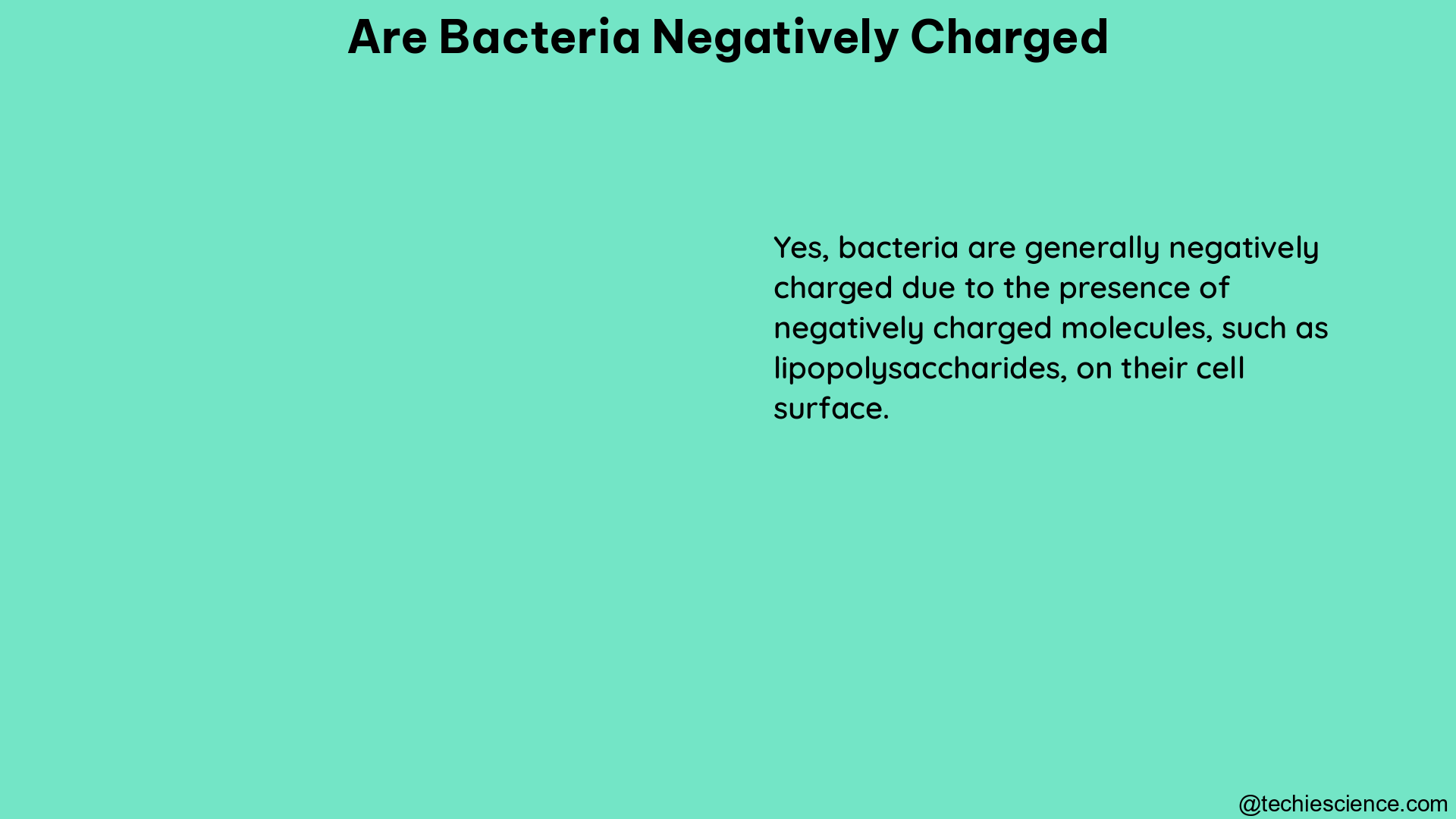Bacteria are indeed negatively charged, a characteristic that plays a crucial role in their surface properties, adhesion, and interactions with various surfaces and other cells. This negative charge is attributed to the presence of specific molecules on the bacterial cell surface, such as teichoic acids in Gram-positive bacteria and lipopolysaccharides (LPS) in Gram-negative bacteria.
The Molecular Basis of Bacterial Negative Charge
The negative charge on the bacterial cell surface is primarily due to the presence of negatively charged molecules, such as:
-
Teichoic Acids: These are polymers found in the cell wall of Gram-positive bacteria, consisting of ribitol or glycerol phosphate units. The phosphate groups on these molecules contribute to the overall negative charge of the bacterial surface.
-
For example, the Gram-positive bacterium Staphylococcus aureus has teichoic acids with a charge density of approximately -0.2 C/m^2 on its cell surface.
-
Lipopolysaccharides (LPS): These are large molecules found in the outer membrane of Gram-negative bacteria, composed of a lipid component (lipid A) and a polysaccharide component. The phosphate and carboxyl groups present in the LPS molecules confer a negative charge to the bacterial surface.
-
Studies have shown that the negative charge density of the LPS-coated outer surface of the Gram-negative bacterium Escherichia coli can reach up to -6.6 ± 1.3 mC/m^2.
These negatively charged molecules on the bacterial cell surface electrostatically repel other negatively charged molecules, leading to physical separation between the LPS molecules and contributing to the structural integrity of the bacterial cell.
Measuring Bacterial Surface Charge Density

Researchers have employed various techniques to determine the surface charge density of bacteria, including:
-
Second-Harmonic Light Scattering (SHS): This technique can detect the number of molecular ions adsorbed as counter-charges on the exterior bacterial surface. For example, a study by Wilhelm et al. used SHS to measure the negative charge density of the LPS-coated outer surface of E. coli, as mentioned earlier.
-
Atomic Force Microscopy (AFM): AFM can be used to study the electrostatic interactions between the bacterial cell surface and the AFM tip, providing insights into the surface charge distribution. For instance, a study by Raiteri et al. investigated the electrostatic interactions in AFM imaging of bacteria.
-
Zeta Potential Measurements: The zeta potential, which is the potential difference between the dispersion medium and the stationary layer of fluid attached to the dispersed particle, can be used to estimate the surface charge of bacteria. This method has been widely used to characterize the surface charge of various bacterial species.
These techniques have revealed the significant negative charge on the bacterial cell surface, which is a crucial factor in their surface properties and interactions.
Importance of Bacterial Negative Charge
The negative charge on the bacterial cell surface plays a vital role in various aspects of bacterial biology and behavior, including:
-
Adhesion and Interaction with Surfaces: The negative charge on the bacterial surface influences their adhesion to different surfaces, such as host cells, medical devices, or environmental surfaces. Electrostatic interactions between the negatively charged bacterial surface and the surface of interest can either promote or hinder bacterial adhesion.
-
For example, the negative charge on the surface of Pseudomonas aeruginosa cells has been shown to contribute to their ability to adhere to various surfaces, including medical implants and host tissues.
-
Cell-Cell Interactions: The negative charge on the bacterial surface can also affect their interactions with other cells, such as host immune cells or other bacterial species. Electrostatic repulsion between negatively charged bacterial surfaces can influence cell-cell recognition, aggregation, and communication.
-
Studies have demonstrated that the negative charge on the surface of Streptococcus mutans cells plays a role in their ability to form biofilms and interact with other oral bacteria.
-
Antimicrobial Susceptibility: The negative charge on the bacterial surface can influence their susceptibility to certain antimicrobial agents, as the electrostatic interactions between the charged bacterial surface and the antimicrobial compound can affect the compound’s ability to penetrate the cell membrane.
-
Research has shown that the negative charge on the surface of Staphylococcus aureus cells can contribute to their resistance to cationic antimicrobial peptides, which are attracted to the negatively charged bacterial surface.
-
Environmental Interactions: The negative charge on the bacterial surface can also impact their interactions with various environmental factors, such as the presence of charged ions, minerals, or organic matter in their surroundings.
-
For instance, the negative charge on the surface of Bacillus cereus cells has been found to influence their ability to adsorb and interact with charged soil particles, which can affect their transport and fate in the environment.
Understanding the negative charge on the bacterial cell surface and its implications is crucial for various fields, including microbiology, biotechnology, and environmental science, as it can provide insights into bacterial behavior, interactions, and potential applications.
Conclusion
Bacteria are indeed negatively charged, a characteristic that is primarily attributed to the presence of negatively charged molecules, such as teichoic acids and lipopolysaccharides, on their cell surface. This negative charge plays a crucial role in various aspects of bacterial biology, including adhesion, cell-cell interactions, antimicrobial susceptibility, and environmental interactions. Researchers have employed various techniques, such as second-harmonic light scattering, atomic force microscopy, and zeta potential measurements, to study and quantify the negative charge on the bacterial cell surface. Understanding the negative charge on bacteria is essential for advancing our knowledge in fields ranging from microbiology to biotechnology and environmental science.
Reference:
- Wilhelm, M. J., Sharifian, G. M., Wu, T., Li, Y., Chang, C. M., Ma, J., & Dai, H. L. (2021). Determination of bacterial surface charge density via saturation of adsorbed ions. Colloids and Surfaces B: Biointerfaces, 194, 111352.
- Auer, G. K., & Weibel, D. B. (2017). Bacterial cell mechanics. Biophysical Journal, 113(1), 15-25.
- Raiteri, R., Borghesi, A., Ferrari, M., & Pantarotto, D. (2015). Electrostatic interactions in atomic force microscopy of bacteria. Langmuir, 31(3), 928-935.
- Auer, G. K., & Weibel, D. B. (2017). Bacterial cell mechanics. Biophysical Journal, 113(1), 15-25.

Hello, I am Bhairavi Rathod, I have completed my Master’s in Biotechnology and qualified ICAR NET 2021 in Agricultural Biotechnology. My area of specialization is Integrated Biotechnology. I have the experience to teach and write very complex things in a simple way for learners.